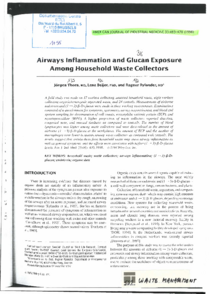Airways inflammation and glucan exposure among household waste collectors

Thorn, Jörgen ; Beijer, Lena ; Rylander, Ragnar
American Journal of Industrial Medicine
1998
33
5
463-470
exposure ; household maintenance products ; organic dust ; questionnaire survey ; refuse collection ; respiratory diseases ; spirometry ; waste disposal
Occupational risks
English
he relationship between the amounts of airborne (1-3)-beta-D-glucan and endotoxin and airway inflammation among Swedish waste collectors was investigated. The study concentrated particularly on those collecting compostable waste, and the aim was to evaluate the usefulness of objective measurements of inflammation in these workers. The study cohort included all compostable waste collectors and those collecting unsorted waste (17 workers) in the city of Kristianstad, Sweden. Measurements were made of the amounts of airborne glucan and endotoxin at the work sites and in the offices of the control group (24 workers). The subjects were also interviewed using a slightly modified standard questionnaire to assess organic dust induced effects. The incidence of diarrhea, nasal congestion, and unusual tiredness was higher among the study subjects than in the control group. The number of blood lymphocytes was also higher among waste collectors and was dose related to the amount of airborne (1-3)-beta-D-glucan at the workplaces. The amount of eosinophilic cationic protein and the number of macrophages were lower in the sputum among waste collectors as compared with controls. The authors conclude that certain dusts from household waste may cause airway inflammation as well as general symptoms, and that these effects were associated with higher (1-3)-beta-D-glucan levels.
Digital
The ETUI is co-funded by the European Union. Views and opinions expressed are however those of the author(s) only and do not necessarily reflect those of the European Union or the ETUI.